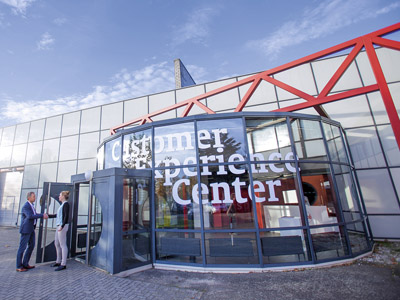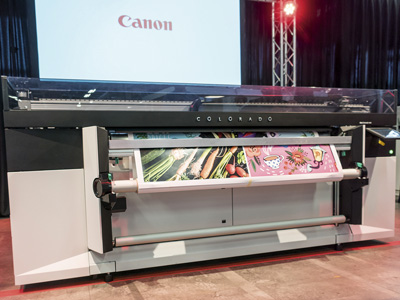Canon Colorado 1640
Canon has delivered on its promise made last year to bring a ‘new’ type of ink and printer to the wide-format sector. Simon Eccles went to see.
Six months ago Canon announced that it was launching a new UV ink technology called UVgel and an accompanying wide format signage printer, that would be both revolutionary and economical with ink. As every other announcement we see is labelled revolutionary, we filed this one under ‘let’s wait and see’.
Last month at its Customer Experience Centre in Venlo, Holland, the company unveiled its new Colorado 1640 UVgel roll to roll printer to the European press and showed it working. This was a preview before a public launch at FESPA in Hamburg during May. The first commercial user will be Comdatek in Hückeldhoven, Germany, about 50 km south of Venlo, who will mainly use the printer for wallcoverings.

Canon’s customer experience centre in Venlo hosted the UVgel printer launch
Dirk Brouns is Canon’s director of strategy and business development for industrial and production solutions. He said that demand for roll-to-roll wide format signage print will increase by 50% over the next five years. While Canon has produced its own flatbed UV Arizona printers since 2007, it has not had a presence in roll-fed UV-cured printing before, apart from roll options on some of the Arizona models. The printer, print heads and ink are manufactured at the Océ factories in Venlo.
The Colorado 1640 is a true signage printer, intended for ‘businesses producing indoor and outdoor applications including posters, banners, signage, POS, billboards, window graphics, decals and bespoke wall coverings,’ says Canon. It can do some soft signage. There isn’t a catch gutter but Canon thinks the ink should work with close-woven textiles like banners and pop-ups as it won’t soak through. It wouldn’t be suitable for flags, however.
The new printer has some interesting automation capabilities beyond the UVgel ink. The compact but heavy-duty rigid metal chassis is built for high throughput and high dot placement accuracy. Speed is 40 m2/hr at production quality for close-up POS work, with 57 and 117 m2/h offered for lower quality or more distant viewing applications. The price will be €55,000; ink will cost €135 per litre.
Gelling nicely
UVgel is a UV-cured pigment ink that is supplied as a high viscosity gel rather than the usual liquid. It is pumped to special Océ-made piezo inkjet heads that incorporate a heater to warm the ink and lower its viscosity before it reaches the ink chambers and nozzles. Automatic monitoring uses acoustic sampling to detect and correct any underperforming nozzles, while optical media measuring compensates for uneven feeding. Canon says this virtually eliminates white lines and banding, so fewer passes are needed to cover up problems. This, together with the multi-roll support and other automation features, aids unattended printing.
The ink is jetted as droplets in the usual way, but when it reaches the cool (28 degrees C) substrate surface it instantly reverts to a gel and stops flowing – “pinned” in inkjet lingo. The drops don’t spread and merge, so there is no dot gain and the spots remain very sharp. The maker claims that ink usage is reduced by 40% compared to “competitive technologies”, thanks to a more efficient way of jetting ink, reduced maintenance and by removing the need for optimisers.
This pinning allows the LED UV curing lamps to run on a separate carriage to the print heads. LEDs run cool and use little power compared with eco-solvents, latex or conventional UV lamp curing, all of which require significant heat. This means that thinner and therefore cheaper vinyl and other heat-sensitive media can be used without distortion.
The ink emerges from the printer dry and ready to finish or deliver. There is no odour, unlike solvent inks or some conventional UV ones. There are HAPs (hazardous air pollutants) and Canon is applying for independent certification for indoor use in sensitive environments such as hospitals and schools.
Durability, colour and choices
The company is a bit vague about outdoor durability, saying that most users will laminate UVgel print for protection, but it seems to be about the same as flexible UV inks. Canon claims that fade resistance is significantly better than with HP latex and says it has optimised the ink for scratch resistance over stretching. It can be used for unlaminated floor graphics but isn’t recommended for vehicle wraps with tight curves. UVgel has a respectably wide colour gamut from CMYK, claimed to be similar or better than HP latex and an unnamed eco solvent.
The Colorado 1640 has “multi-roll” capability and can hold two feeder rolls of media, automatically switching when one runs out. This allows longer unattended running. The two rolls can also be different materials, with front-end commands to switch between them.
So, revolutionary? Up to a point. Anyone buying though would likely also first take a look at Mimaki’s remarkably good value UJV55-320, a 3.2 m UV-LED printer introduced a year ago for around £60,000. Fujifilm sells a version of the same thing as the Acuity LED 3200R. Speed comparisons are hard to judge, but the Mimaki has roughly the same per-hour throughput with just CMYK on vinyl, but it does support up to seven colours including white. Although linear speeds of the Mimaki are slower, it can print two 1.5 m rolls simultaneously. The Canon is CMYK-only; Brouns says that extra “light” colours aren’t needed due to the Colorado’s quality, but so far there is no white ink. The Mimaki has greyscale printheads while the Colorado’s are the binary 10-picolitre type.
The Colorado 1640 is the first of a planned family of Colorado roll-fed printers. Wider models are likely and possibly smaller, lower-priced ones to compete with eco-solvent printers and the entry-level HP latex models too.
How about using the heads and UVgel ink in a future flatbed in the Arizona family? It’s not ruled out, but not imminent either, apparently.
In 2008 Xerox talked about using a UV-cured gel ink in a forthcoming production press that could print on plastics as well as paper. In the event it switched to solid wax ink and paper only in the CiPress. But might Canon use UVgel in a future version of its JetStream or ColorStream commercial inkjet web presses? ‘Can’t say,’ replied Dirk Brouns.
Read the full April issue online here





